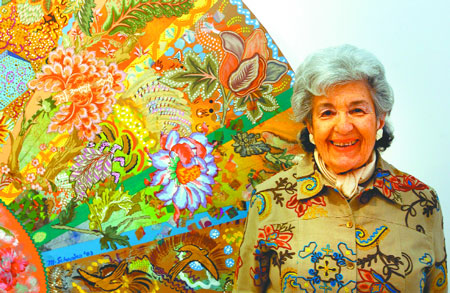By Ellison Walcott
The month of March may be Women’s History month but there’s no excuse needed to see a comprehensive, yet intimate exhibit by one of the pioneers in feminist art.
Miriam Schapiro’s retrospective currently on view at Kristen Frederickson Contemporary Art on Reade St. is but a small representation of a 30-year career. Still, the eight works of art in the gallery provide a full survey of her career, her development as an artist, her thinking and ideas.
Now 80, Miriam Schapiro is known to her friends as Mimi. On a recent February afternoon at the gallery she was sporting a clay-colored jacket with embroidered flowers. If it weren’t for the contours of her animated face, she would blend right in to the artwork on the walls. Her cream-colored earrings even share the shape of one of one of her pieces on exhibit, ‘Pleasure Dome.’
“I’m not a mechanic,” said Schapiro. “So I don’t stand everyday and go at the canvas at the same time. I have to be really inspired.”
Schapiro is celebrated as a feminist artist who emerged into the art scene during the late Abstract Expressionist period in the early 1960’s. Later that same decade, she was instrumental in the growth of the ‘Pattern and Decoration’ movement, an aesthetic development designed to destabilize preconceptions of high art. Proponents embraced traditional concepts of beauty and humor in an age of austerity and intellect. Events included fashion shows and kimonos and fans served as canvases.
In 1969, the first formal Feminist Art Program was organized by Judy Chicago at California State University, Fresno. A year later Schapiro was recruited as the program’s co-director at the California Institute of the Arts in Valencia and the historically and politically significant installation, “Womanhouse,” was soon to follow.
“Womanhouse” was a site-specific installation executed in 1972. Twenty-one students in the Feminist Art Program at the Cal Institute of Arts, in collaboration with Judy Chicago and Schapiro, transformed the rooms in a condemned mansion in residential Hollywood into an installation artwork about women, their domestic roles and the many societal issues they face.
Schapiro’s modus operandi hasn’t changed over the years. She overlays her painted, architecturally-based patterns with collaged elements of fabric, lace, paint and often whole objects in mixed media.
Given the proliferation of images and patterning in Schapiro’s work, her influences are many. However, it is her father who was the initial inspiration for Schapiro’s choice of career. That and her Russian ancestry have served as important touchstones throughout the decades.
“I grew up during the Depression,” said Schapiro whose father worked on the art program of the WPA. “When he was gone during the week he would give me the assignment to draw a picture a day. I didn’t want to. I wanted to go out and play, so I would draw them all the night before he came home. Then he would give a crit of my work.”
The most recent paintings in the gallery were inspired by a lecture Schapiro gave at the University of Nebraska on quilts.
One of these paintings titled “Life of Dolls” 2003, has a strong structural base. At the foundation the piece is composed of a four-square bisected with a circle. Structurally this form is a building block of quilt patternation. Here is where the structure ends, however, with African American and Caucasian dolls populating the colorful fields of mint green, pink, lavender and sky blue. Flowers, fans, leaves and ornamental filigree animate the surface further.
“While I was there I saw a great many quilts,” said Schapiro. “I started thinking about the women who made the quilts and this is what I gave my talk on. When I got home I decided I wanted to make my own quilt, so I took a canvas out of the closet that had been in there for years.”
Schapiro’s work has always had a narrative quality and each piece has its own history, both in the making as well as in content. All the works have a connection to women and community, whether motivated by viewing quilts, or attending a flea market and finding embroidered objects such as lace doilies.
Perhaps the most engaging piece in the show is a series of prints executed in 1977. On one of the gallery walls hang twelve prints containing images of doilies titled “Anonymous Was a Woman.” This series of prints was made from actual doilies, the lacy cloths of flowers, hearts and birds.
“I chose this media because traditional women’s work, such as embroidery and crocheting, were not signed,” said Schapiro.
While the prints are flat to the paper, they have a tactility and sculptural quality. The fabrication has a purity that matches the subject matter.
The other pieces in the gallery have an abundance of imagery including tap dancers, African masks, flowers, dolls and deer. Media and materials are as profuse and they include acrylic paint, sequins, fabric, color Xerox, lace and handkerchiefs.
In today’s brash art landscape, Shapiro stands as a godmother to artists weaned academically on the accomplishment of the past, as well as a grand example of the tenacity of artistic drive in the present.
Reader Services
Read More: https://www.amny.com/business-finance/


































